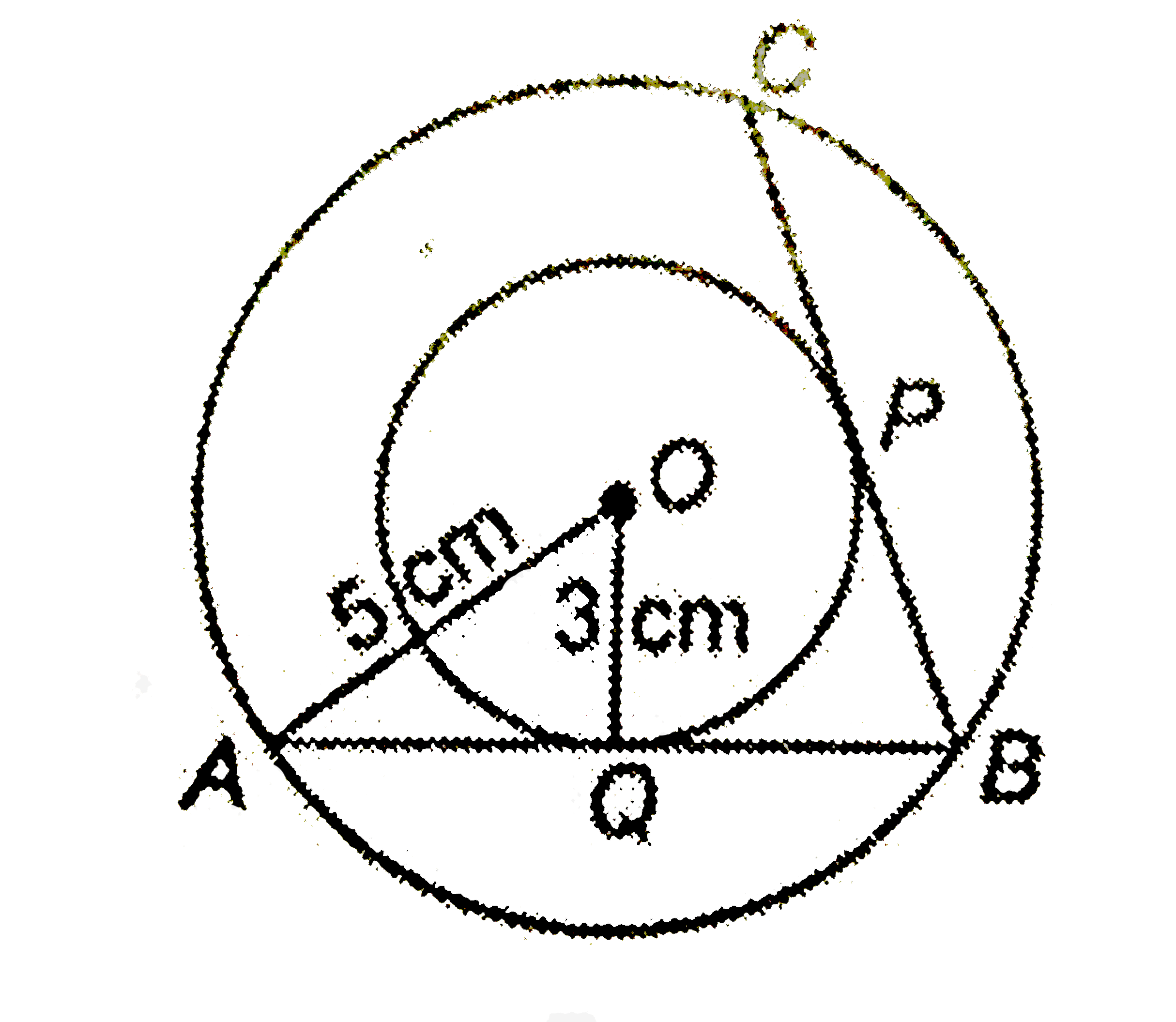Draw two concentric circles of radii 3 cm and 5 cm . Taking a point on outer circle construct the pair of tangents to the other. Measure the length of a tangent and verify it by actual calculation .
Step-by-Step Solution
Step 1: Draw Two Concentric Circles
- Begin by drawing a point O, which will be the center of both circles.
- Using a compass, draw a circle with a radius of 5 cm (let's call this Circle C2).
- Without changing the compass width, draw another circle with a radius of 3 cm (let's call this Circle C1). Both circles should share the same center O.
Step 2: Mark a Point on the Outer Circle
- Choose any point P on the circumference of the outer circle C2.
Step 3: Draw a Diameter
- Draw a straight line from the center O to the point P. This line OP will serve as the diameter for the next circle.
Step 4: Construct a Circle with Diameter OP
- With OP as the diameter, use a compass to draw a new circle (let's call this Circle C3). This circle will intersect the inner circle C1 at two points, which we will call A and B.
Step 5: Draw Tangents
- Draw straight lines from points A and B to point P. These lines AP and BP are the required tangents to the inner circle C1 from the point P.
Step 6: Measure the Length of the Tangents
- Use a ruler to measure the lengths of the tangents AP and BP. Let's say the measured length is approximately 4.1 cm.
Step 7: Calculate the Length of the Tangents Using Pythagorean Theorem
- In triangle OAP:
- OP=5 cm (radius of the outer circle)
- OA=3 cm (radius of the inner circle)
- According to the Pythagorean theorem:
OP2=OA2+AP2
52=32+AP2
25=9+AP2
AP2=25−9=16
AP=√16=4 cm
Step 8: Verify the Measured Length
- The calculated length of the tangent AP is 4 cm, while the measured length is approximately 4.1 cm.
- The difference between the measured and calculated lengths is:
Difference=4.1 cm−4 cm=0.1 cm
- This difference can be considered as the error in measurement.
- Begin by drawing a point O, which will be the center of both circles.
- Using a compass, draw a circle with a radius of 5 cm (let's call this Circle C2).
- Without changing the compass width, draw another circle with a radius of 3 cm (let's call this Circle C1). Both circles should share the same center O.
- Choose any point P on the circumference of the outer circle C2.
- Draw a straight line from the center O to the point P. This line OP will serve as the diameter for the next circle.
- With OP as the diameter, use a compass to draw a new circle (let's call this Circle C3). This circle will intersect the inner circle C1 at two points, which we will call A and B.
- Draw straight lines from points A and B to point P. These lines AP and BP are the required tangents to the inner circle C1 from the point P.
- Use a ruler to measure the lengths of the tangents AP and BP. Let's say the measured length is approximately 4.1 cm.
- In triangle OAP:
- OP=5 cm (radius of the outer circle)
- OA=3 cm (radius of the inner circle)
- According to the Pythagorean theorem:
OP2=OA2+AP2
52=32+AP2
25=9+AP2
AP2=25−9=16
AP=√16=4 cm
- The calculated length of the tangent AP is 4 cm, while the measured length is approximately 4.1 cm.
- The difference between the measured and calculated lengths is:
Difference=4.1 cm−4 cm=0.1 cm
- This difference can be considered as the error in measurement.
Topper's Solved these Questions
- BOOK - NCERT EXEMPLAR ENGLISHCHAPTER - CONSTRUCTIONSEXERCISE - Exercise 10.3 short Answer type Questions4videos
CONSTRUCTIONS
- BOOK - NCERT EXEMPLAR ENGLISHCHAPTER - CIRCLESEXERCISE - EXERCISE 9.4 LONG ANSWER TYPE QUESTIONS14videos
CIRCLES
- BOOK - NCERT EXEMPLAR ENGLISHCHAPTER - COORDINATE GEOMETRYEXERCISE - Exercise 7.4 Long Answer Type Questions6videos
COORDINATE GEOMETRY
Similar Questions
Draw two concentric circles of radii 3 cm and 5 cm. Taking a point on outer circle, construct the pair of tangents to the other. Measure the length of a tangent and verify is by actual calculation.
View SolutionDraw two concentric circles with radii 4 cm and 6 cm. Taking a point on the outer circle, construct a pair of tangents to inner circle. By measuring the lengths of both the tangents, show that they are equal to each other.
View SolutionDraw a circle of radius 6cm. From a point 10cm away from its centre, construct the pair of tangents to the circle and measure their lengths.
View SolutionDraw a circle of radius 4 cm. From the point 7 cm away from its centre, construct the pair of tangents to the circle.
View SolutionIf radii of two concentric circles are 4 cm and 5 cm, then length of each chord of one circle which is tangent to the other circle, is
View SolutionDraw a circle of radius 5.0 cm. Take a point P on it. Without using the centre of the circle construct a tangent at the point P.
View SolutionDraw a circle with the help of a bangle. Take a point outside the circle. Construct the pair of tangents from this points to the circle.
View SolutionTwo concentric circle of radii 3cm and 5cm are given. Find the chord BC which touches the inner circle at P.
 View Solution
View SolutionDraw a circle with the help of a bangle. Take a point outside the circle. Construct the pair of tangents from this point to the circle.
View SolutionTwo concentric circles are of radii 13 cm and 5 cm. Find the length of the chord of the larger circle which touches the inner circle.
View Solution

